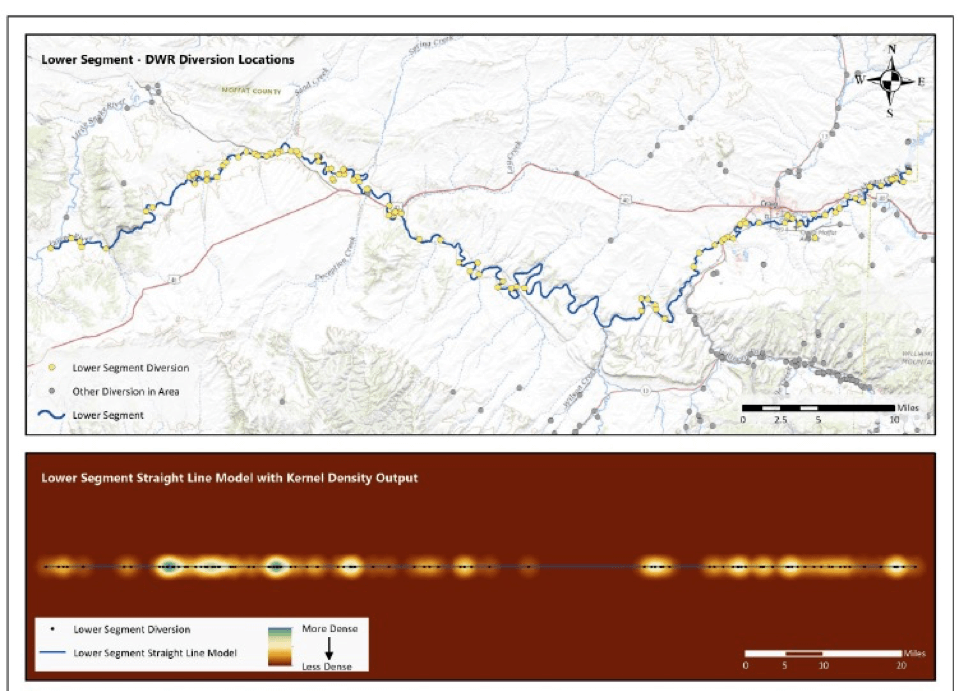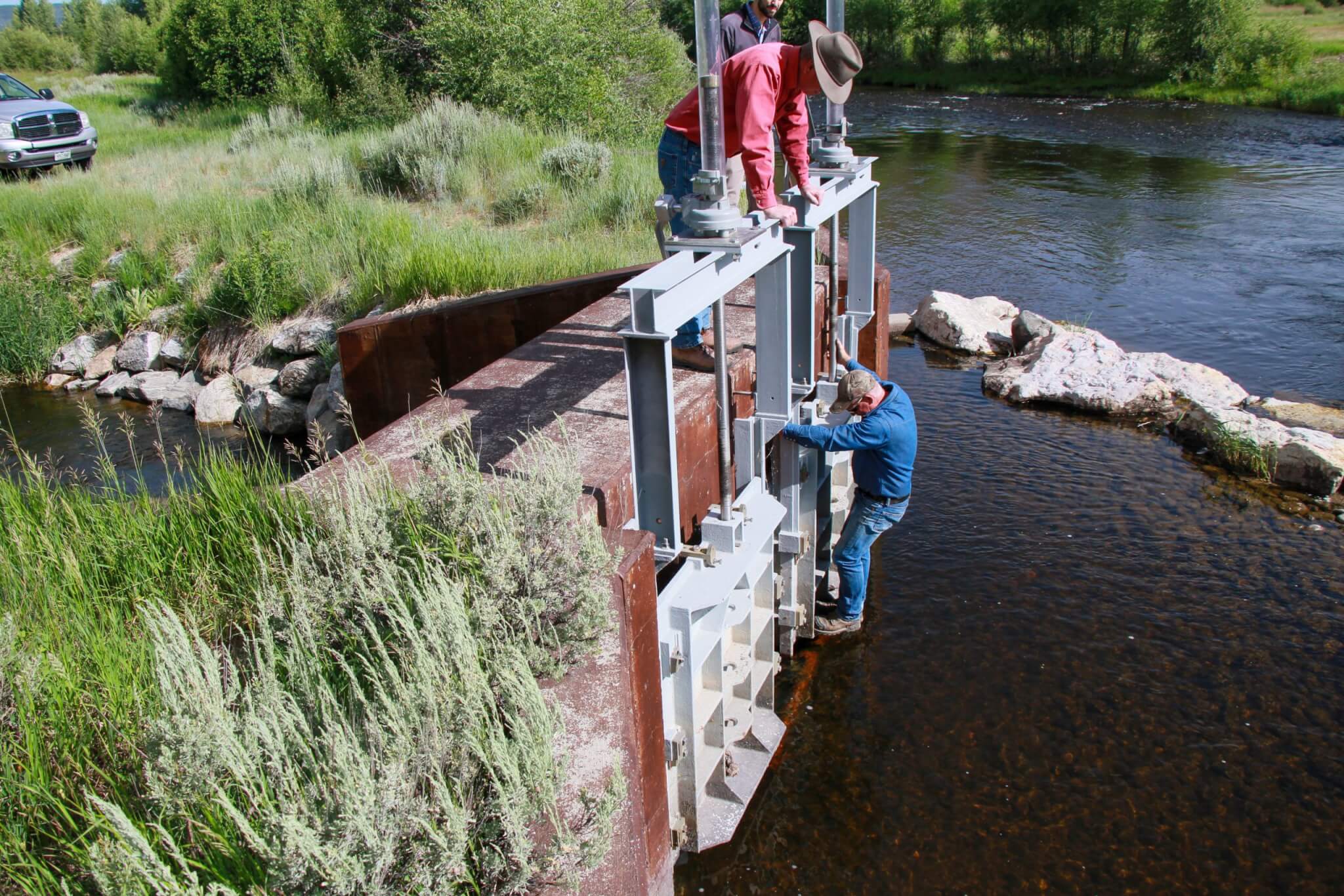Aligning with Agriculture for Multiple Benefits on All 300+ Miles of the Yampa
How do you support river health and engage irrigators along 300 plus miles of river and with nearly 250 individually owned diversion structures? It’s tough, but rewarding, and exactly what River Network and our partners have been up to in the Yampa river basin recently.
The Yampa River in northwest Colorado is often cited as the last best example of a free-flowing western river, but it faces some tough challenges ahead including declining flows, increased recreational use, growth of higher intensity riverside land uses, and too-warm water temperatures. The river also flows through a predominately rural, agricultural landscape and provides water to hundreds of small family-owned cattle ranches. So, any voluntary solutions to the river’s stressors must provide co-benefits to irrigators to have a chance at success.
This confluence of factors makes our work to connect and build trust among conservation and agricultural partners in the basin a fascinating case study and proving ground for our broader efforts to more deeply and meaningfully engage agricultural interests in planning processes for healthy rivers nationwide.
For the last few years, River Network has worked closely with a diverse mix of local partners, leading the Yampa White Green Basin Roundtable’s Integrated Water Management Plan (IWMP). River Network’s leadership of the IWMP, and the resulting regular conversations and shared goals and objectives has improved the basin’s capacity for collective action. Prior to this planning effort, water-focused groups in the Yampa basin tended to operate in silos and not work together strategically. Since aligning under the IWMP, the partners who make up its committee combined community input with science and engineering assessments to identify actions that protect existing and future water uses and support healthy river ecosystems in the face of growing populations, changing land uses, and climate uncertainty. We, in collaboration with our IWMP partners, have worked hard to engage agricultural interests in the Yampa, and this work is now proving successful.
And it was hard work: engaging irrigators along 300-plus miles of river is tough on its own, but a lack of ditch companies, irrigation cooperatives, and other formal mechanisms to convene them made it even tougher. The Yampa River mainstem also has almost 250 individually owned irrigation diversion structures, many of them mere yards apart.
“One of the initial challenges was simply identifying the right people to talk to about a specific diversion or ditch. Not having large ditch companies or irrigation cooperatives, we had to do quite a bit of research and contacting people to find the right person. Scheduling in-person or phone conversations once COVID restrictions were in place was also challenging. As you know [agriculture] people are busy all year long. But that was also the most valuable lesson learned… that you need to take the time to build that trust and understanding not only with a primary contact person but with all the related ditch owners and family members. It’s a time consuming process, but worth the effort.”
– Patrick Stanko, Community Agriculture Alliance

Diversions along the Yampa River.
To build relationships and identify feasible opportunities in such a loosely organized environment required a labor-intensive engagement approach. IWMP project staff spent a year interviewing over 110 agricultural stakeholders to identify early actions to meet future water needs, community recreation desires, and ensure a healthy river. We also conducted assessments of 45 diversion structures to understand where opportunities exist for infrastructure improvements that benefit everyone: the irrigators who own the structures, the river itself, life in the river, and the people and communities who flock to the Yampa for recreation.
“There has long been a mindset wherever water resources are shared and limited that maintaining or promoting the interests of one sector of the economy or community necessarily limits or impacts other sectors. I don’t believe that that has to be the case. I see the health of the river as is in everyone’s interest and as something that can be addressed through education, innovation, and collaboration. By bringing good science to the dialogue, engaging all stakeholders in identifying challenges, and being creative and innovative with solutions, I believe we can maintain the agricultural heritage of the Yampa River valley and protect and restore the health of the river ecosystem.”
– Peter Skidmore, Walton Family Foundation

The ideas that surfaced during these interviews included identifying river locations where there are both environmental and agricultural needs where “low-tech” methods can be implemented to improve riverside land condition and its connection to river flows; spots where existing and/or future shortages occur and whether new water storage could help; areas where new or improved agricultural infrastructure would have benefits for all; and work to better understand river flow needs.
Underscored throughout the process, however, was one major emergent need: additional, focused capacity in the basin to assist irrigators in pursuing upgrades to their infrastructure that would benefit both their operations and the river. As Beverly Powell, land owner and head of Shelton Ditch in Hayden, CO who participated in the diversion assessment, put it:
“The IWMP Diversion Assessment identified several improvements and opportunities to be more effective with our ditch use. The question is what now? We have ten irrigators on our ditch and trying to get everyone in agreement and working together is challenging. It would make a huge difference for us if we had someone to organize projects and coordinate with all the owners. We don’t have the expertise or resources to find funding and complete grant applications. Having someone to facilitate projects in the Yampa Valley could help all water users.”
Hearing this need loud and clear, River Network teamed up with Steamboat Springs’ Community Agriculture Alliance, pursuing and receiving funding from the Colorado Water Conservation Board to hire a new “Ag Coordinator” position in the basin that will do just that, bringing additional capacity to help irrigators act.
We’re thrilled to get started and continue supporting the basin, recognizing that it isn’t enough to drop in and identify the challenges, without sticking around to support the solutions. Through this new position, we’ll collaborate to:
- Build trust and provide needed services to agricultural landowners.
- Incorporate river ecology goals into agricultural irrigation upgrade projects.
- Develop stronger partnerships between agriculture and conservation organizations.
- Develop a replicable and scalable approach to increase agricultural irrigation project proposals.
- Help stretch available water resources further.
As the IWMP moves toward finalizing its action plans in early 2022, and shifts to implementation, there is a need for a formalized conservation partnership amongst the water-focused groups in the basin. Through the IWMP, River Network has been the de facto lead in this area for the last few years, developing deep knowledge of the people, issues and challenges related to management of the Yampa River. We hope to continue acting as the “glue” that binds local organizations’ efforts together.
But the work doesn’t end in Colorado. River Network holds this central convening role in several watersheds in the United States, and this role is at the core our capacity building mission. Our work in the Yampa River basin provides a number of examples and case studies on how to engage agricultural water users in conversations about protecting the river they rely on and on watershed planning more generally. We’re excited to share these examples with the broader network and in October 2020, shared the diversion assessment approach and results with our Stream Management Planning Peer Learning Network.
“The Yampa River is representative of many of the challenges facing all rural rivers and communities and so presents an opportunity to work to save the values of the special river while also building tools to meet those challenges. Building a framework for collaboration in the Yampa River valley among different interests in the face of a changing climate and shifting demographics presents an opportunity to develop a model collaborative process for other communities.”
-Peter Skidmore, Walton Family Foundation
Of course, we wouldn’t have these learnings to share without the Walton Family Foundation and the large, multi-year investment they are making in the Yampa, or the Colorado Water Conservation Board, which funded much of this work, in addition to the new Ag Coordinator role and project.
Our capacity building work also resulted in more funding, again thanks to partnerships with CWCB and the Walton Family Foundation. These partnerships have grown the overall proverbial pot of funding available for river-related work in the basin, including new positions at Friends of the Yampa and Community Agriculture Alliance, and increased participation by existing staff at River Network, Trout Unlimited and The Nature Conservancy.
We’re proud of the impacts and progress made so far, and eager to start seeing on-the-ground implementation in the Yampa and continued relationship building and collaboration with irrigators and agricultural producers. Together, a future with healthy rivers that support the food and fiber we all depend upon is possible.
To learn more about what we’re hearing from the national network of water protectors working with agricultural producers, read a recent blog post from River Network’s Mikhaela Mullins.





